Do you ever wonder if your WordPress site is actually reaching people? Without proper analytics, you’re basically running it blind. You won’t know which pages visitors enjoy most, how they found you, or what makes them leave without taking action.
That’s why every WordPress site needs Google Analytics (GA). It’s free and gives you the insights you need to understand your visitors and grow your site. Even today, it remains the best way to understand your audience and make smarter decisions.
At WPBeginner, we use MonsterInsights across all our websites because it simplifies complex Google Analytics data into easy-to-understand information. We’ve also looked at other solutions to see what works well for small businesses.
In this guide, we’ll show you three ways to easily set up Google Analytics on your WordPress site — even if you’ve never done anything technical before. 🧑💻

✏️ Quick Note: This is a comprehensive guide – here’s what we’ll cover to help you navigate:
- First, we will explain why Google Analytics is important, how it can help you grow your website, and how to sign up for a GA account if you haven’t already.
- Second, we will show you different methods to install it on your WordPress site. This article covers the MonsterInsights method, along with two alternative approaches.
- Finally, we will explain how to view your traffic reports in Google Analytics.
Why Is Google Analytics Important for Bloggers?
Once you start a blog, your #1 goal is to get more traffic and subscribers. Google Analytics helps you make data-driven decisions by showing you the stats that matter. You can see:
1. Who visits your website?
This part of analytics provides details on the geographical location of your audience, the browser used to visit your site, and other key information, including screen resolution, JavaScript support, Flash support, language, and more.
This data is extremely useful, and it can help in different ways. When creating a custom website design, you can use the user data to make sure that your site will be compatible with your audience.
For example, if you see that most of your visitors are using mobile devices, you can prioritize making your site’s mobile experience as smooth as possible.
2. What do people do when they are on your website?
You can track where the users are going on your website, how long they stay on your website, and the bounce rate (the percentage of users who exit your site on the first visit).
Using this information can decrease the bounce rate and increase your pageviews.
You can also find your most popular articles, articles that are not doing so well, and the kind of content your users are looking for.
3. When do people visit your website?
By looking at the hottest hours of the day for your site, you can pick the best time to publish your post.
If that time zone is not compatible with yours, then you can schedule your post for that hour.
4. How do people find your website?
This section of the analytics shows you where the users come from. For example, do they use search engines, enter direct links, or click on referral links from another site?
It also shows you what percentage of your visitors came from each of these sources. Google Analytics gives you a breakdown of each of these categories. If it is the search engine category, it shows which search engine generated the most traffic for you, such as Google, Yahoo, Bing, and so on.
The breakdown of referral sources shows you which sites you need to work with the most. If your top referral source is Facebook, you need exclusive Facebook content to make your audience feel special.
If your top referral source is an external website, then you might want to consider having a partnership with that website (guest post exchange or something else).
5. How do people interact with your content?
Google Analytics shows how your users interact with your site’s content. It shows you what percent of the users clicked on which link on your site and much more.
You can run A/B split tests by creating content experiments in Google Analytics to understand what works best to meet your goals.
By seeing user interactivity, you can work your content around your users. By seeing the answers to the questions above, you can focus on the strategies that work for your site and avoid methods that don’t work.
Simply put, eliminate the guesswork and focus on stats that matter so you can make data-driven decisions.
Don’t have a Google Analytics account? Just follow our quick step-by-step guide below:
How to Sign Up With Google Analytics
Google Analytics is available for free, and all you need is a Google or Gmail account to sign up. The signup process is quite simple. Just follow the step-by-step instructions below to create your Google Analytics account.
Step 1: Create a Google Analytics Account
First, you need to visit the Google Analytics website to sign up. When you are on the website, simply click the ‘Get started today’ button.
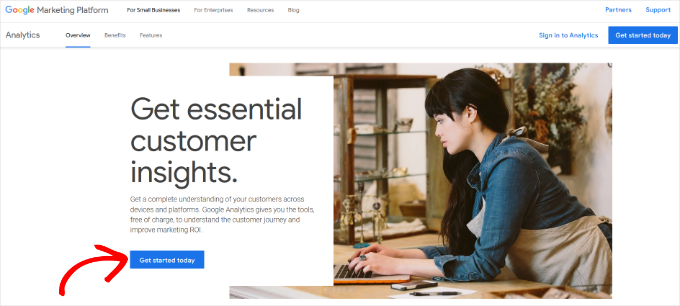
Next, you will be asked to log in with your Google account.
If you already have a Google or Gmail account, then you can use that to sign in. Otherwise, you can go ahead and create a Google account for yourself.
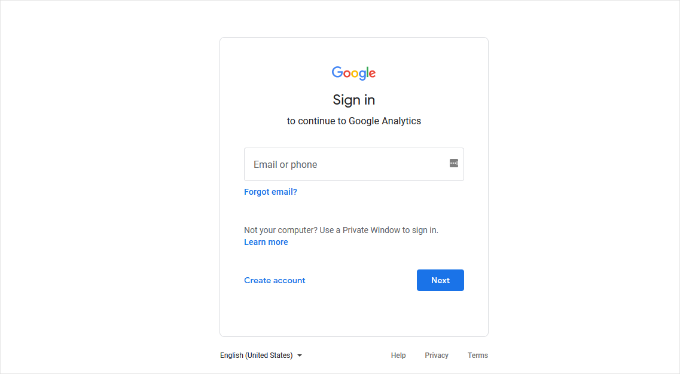
Step 2: Configure Your Google Analytics Account
Once you have signed in with your Gmail account, you will see a welcome screen like the one below.
This is where you will sign up for Google Analytics with your Gmail account. Go ahead and click the ‘Start measuring’ button.
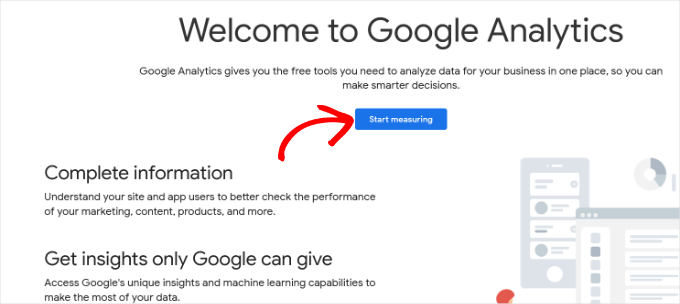
After that, you will be asked to provide an account name.
This name will be used internally, so you can use anything, like your business name.
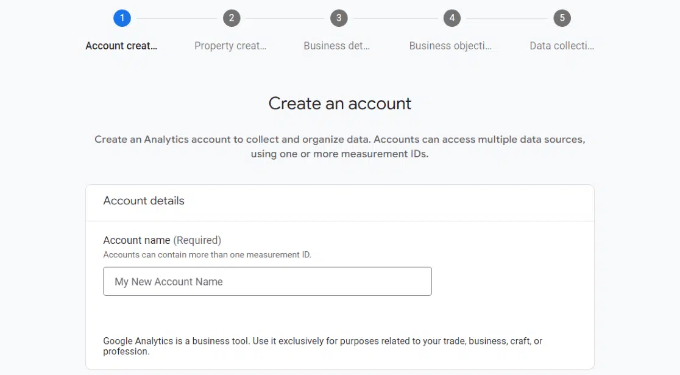
Google Analytics will also show multiple account data-sharing settings.
These settings give you control over sharing your Google Analytics data. You can keep the default settings and move on to the next step.

Step 3: Set Up a Google Analytics Property
On the next screen, you will need to create a Google Analytics property.
Google introduced a new version of Analytics called Google Analytics 4 or GA4. It’s the latest version that tracks your website and mobile apps in the same account. Plus, you get new features, metrics, and a different interface for your reports.
Go ahead and enter a property name and select your reporting time zone and currency. Then click the ‘Next’ button.
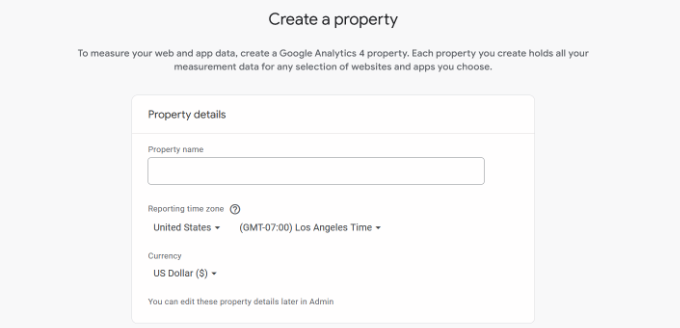
On the next screen, you’ll need to select an ‘Industry category’ from the dropdown menu for your website and choose a ‘Business size’ from the given options.
When you are done, just click the ‘Next’ button.
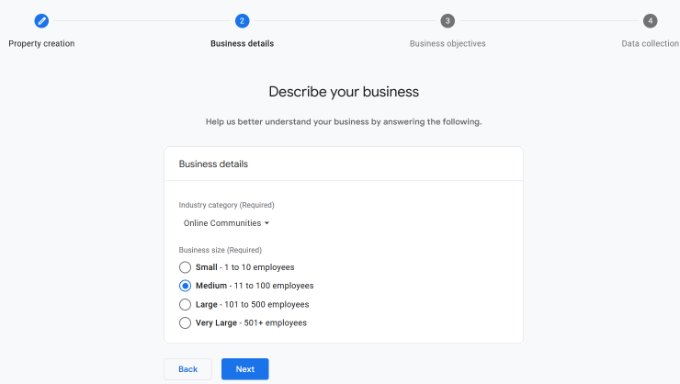
Next, you’ll need to choose business objectives and select how you intend to use Google Analytics with your business. This will help get personalized reports for your business.
For instance, there are options like generating leads, driving online sales, raising brand awareness, examining user behavior, and more.
You can select one or more options that meet your needs. We recommend selecting the ‘Get baseline reports’ option so that you get all the Google Analytics reports populated in your account.
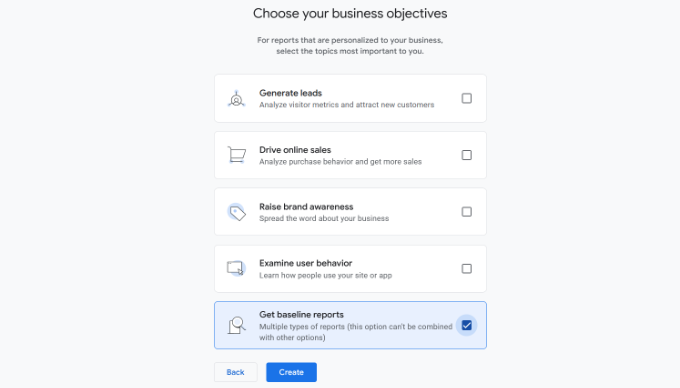
When you are done, simply click the ‘Create’ button.
Step 4: Connect Google Analytics with Your WordPress Site
Now you will be presented with your Google Analytics Webstream options.
Since we are setting up Google Analytics for a WordPress site, go ahead and select ‘Web’ as the platform.
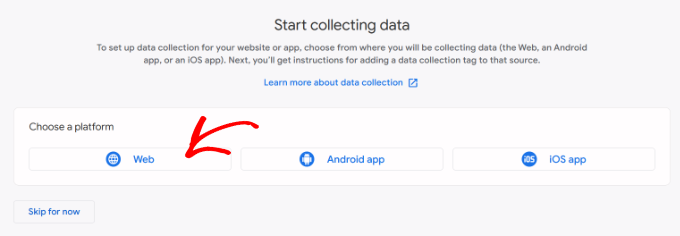
After that, you’ll need to enter your website URL and Stream name.
By default, Google Analytics will have an ‘Enhanced measurement’ option enabled. This allows you to track pageviews, scrolls, outbound clicks, file downloads, and more in Google Analytics.
📝 Note: If you plan to use the MonsterInsights plugin, then you should turn off the ‘Enhanced measurement’ option. Otherwise, the plugin will collect and display double the amount of data.
Next, you can click the ‘Create stream’ button.
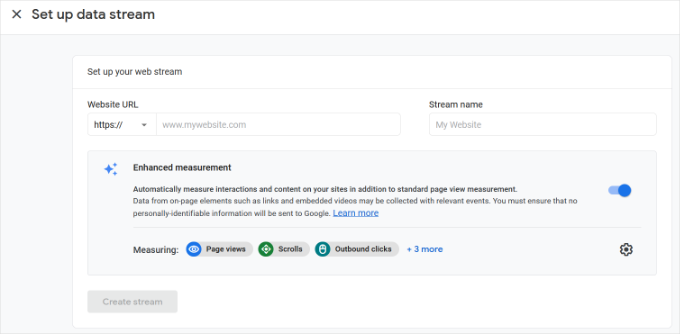
You can now see your Stream name, URL, ID, and Measurement ID.
It will also show different enhanced measurements that it will record.
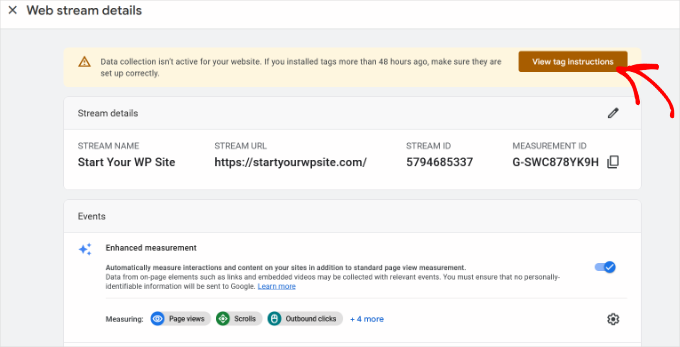
At the top, you will also see an alert bar that will show you how to add Google Analytics to your WordPress site.
Go ahead and click the ‘View tag instructions’ button. You should now see different ways to add the Google Analytics tracking code to your WordPress website.
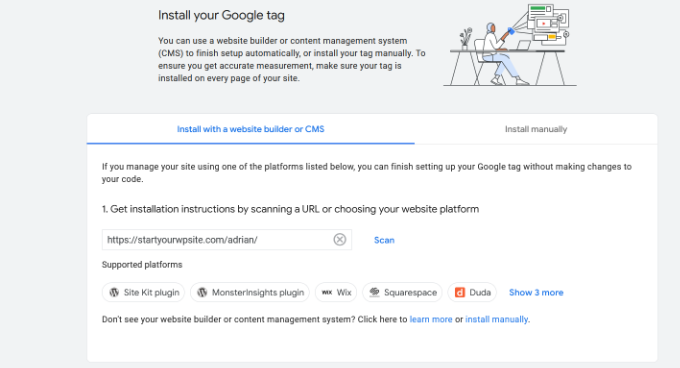
Next, you can switch to the ‘Install manually’ tab.
You’ll then see the Google Analytics tracking code.
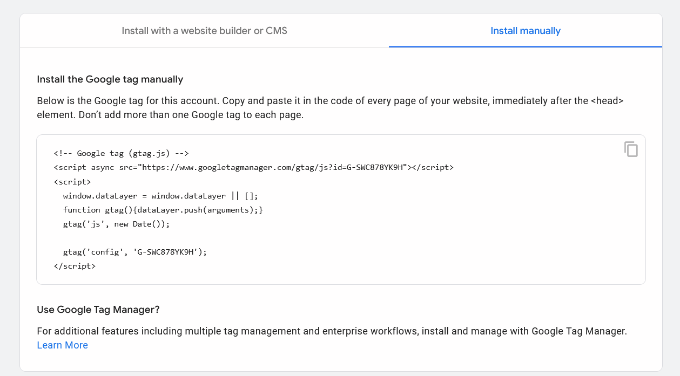
Go ahead and copy this tracking code because you will need to enter it in your WordPress site, depending on the method you use below. You can also simply leave this browser tab open and switch back to copy the code when needed.
We suggest leaving the ‘Analytics’ browser tab open. It’s because you may need to revisit it once you have installed the code on your WordPress site.
Now, let’s take a look at how to install Google Analytics in WordPress. Here is a quick overview of what you’ll learn in this article:
- How to Install Google Analytics in WordPress
- Method 1: Install Google Analytics in WordPress with MonsterInsights (Easy)
- Method 2: Install Google Analytics in WordPress with WPCode (Manual)
- Method 3: Install Google Analytics in WordPress Theme (Advanced)
- Bonus Tip: How to View Reports in Google Analytics
- FAQs About Installing Google Analytics in WordPress
- Video Tutorial: Install Google Analytics in WordPress
- Keep Learning: Using Analytics to Grow Your WordPress Site
How to Install Google Analytics in WordPress
There are a few different ways to set up Google Analytics in WordPress. We will show you three methods, where the first option is the easiest and the last is the hardest.
You can choose the one that best suits your needs.
💡 Pro Tip: You need to use only one of these methods on your website to avoid double-tracking of pageviews in your Google Analytics account.
Method 1: Install Google Analytics in WordPress with MonsterInsights
MonsterInsights is the most popular Google Analytics plugin for WordPress. Over 3 million websites use it, including the likes of Bloomberg, PlayStation, Zillow, WPBeginner, and more.
It is the easiest and, by far, the best way to add Google Analytics to WordPress (for all users, beginners, and experts alike). MonsterInsights is available as both a paid premium plugin and a free version.
At WPBeginner, we use MonsterInsights for various tracking tasks, such as form submissions, CTA button clicks, and referral link performance. Learn why it’s a great plugin in our complete MonsterInsights review.
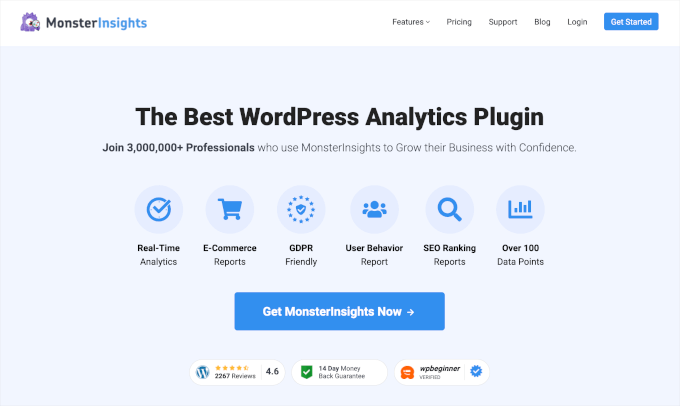
In this tutorial, we will be using the MonsterInsights free version.
You can use the MonsterInsights Pro version if you want more advanced features like eCommerce tracking, ad tracking, author tracking, and so on. The process of setting them up is the same.
Let’s get started.
The first thing you need to do is install and activate the MonsterInsights plugin. For more details, see our step-by-step guide on how to install a WordPress plugin.
Upon activation, the plugin will add a new menu item labeled ‘Insights’ to your WordPress admin menu, and you’ll see a welcome screen. Go ahead and click the ‘Launch the Wizard’ button.

Clicking on it will open the MonsterInsights setup wizard.
First, you will be asked to choose a category for your website (a business website, blog, or online store). Select one and then click on the ‘Save and Continue’ button.
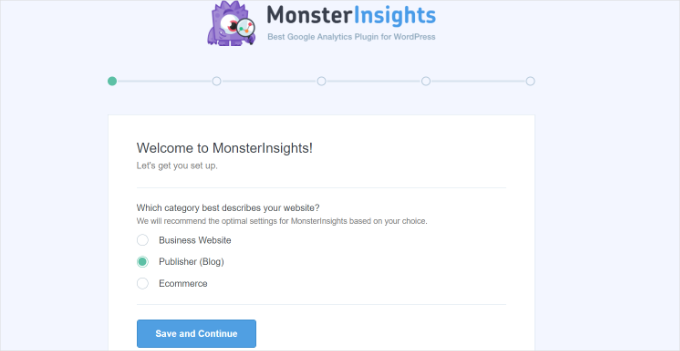
Next, you need to connect MonsterInsights with your WordPress website.
Simply click on the ‘Connect MonsterInsights’ button.
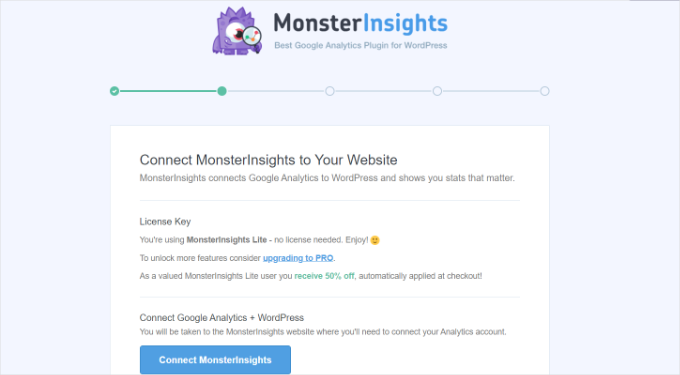
This will take you to Google accounts, where you will be asked to sign in or select a Google account if you are already signed in.
Go ahead and choose your Google account or enter your email to sign in.
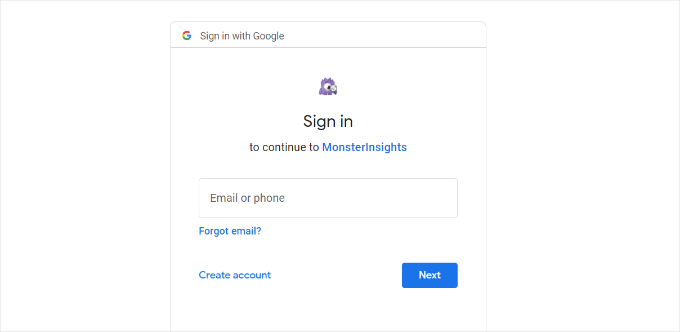
Next, you will be asked to allow MonsterInsights to access your Google Analytics account.
Click on the ‘Allow’ button to continue.
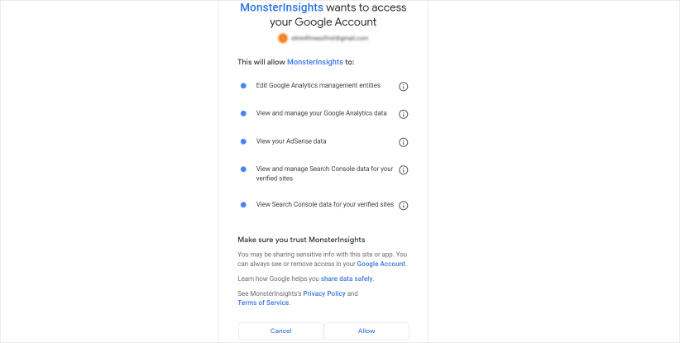
The next step to completing the connection is to select the profile you want to track.
You need to select your website here and then click on the ‘Complete Connection’ button to continue.
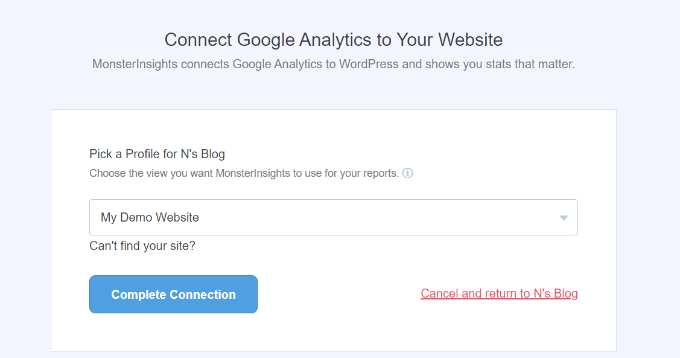
After that, simply click on the ‘Complete Connection’ button to continue. MonsterInsights will now install Google Analytics on your website.
Next, you will be asked to select the recommended settings for your website.
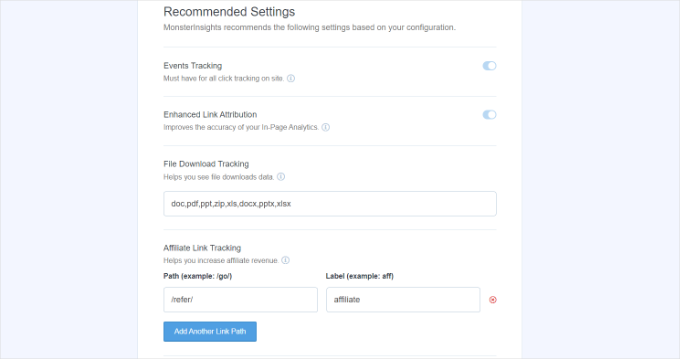
The default settings will work for most websites. If you use an affiliate link plugin, then you need to add the path you use to cloak affiliate links. This will allow you to track your affiliate links in Google Analytics.
MonsterInsights will also ask who can see the reports. You can choose different WordPress user roles.
Once you are done, just click on the ‘Save and Continue’ button to save your settings.
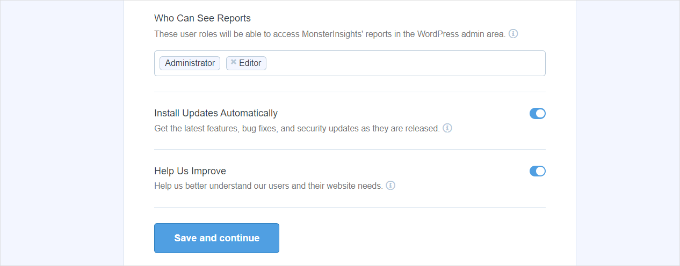
Next, MonsterInsights will show you a list of website tracking features you would like to enable.
You can scroll down and click on the ‘Continue’ button or the ‘Skip for Now’ option.
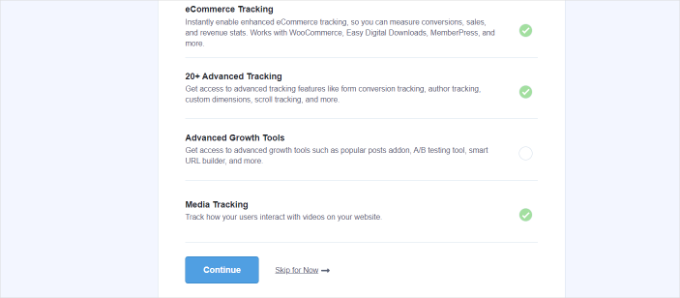
On the next screen, MonsterInsights will show that you’ve successfully set up Google Analytics tracking.
You can see that Google Analytics is connected, the tracking code is installed, and data is now being collected.
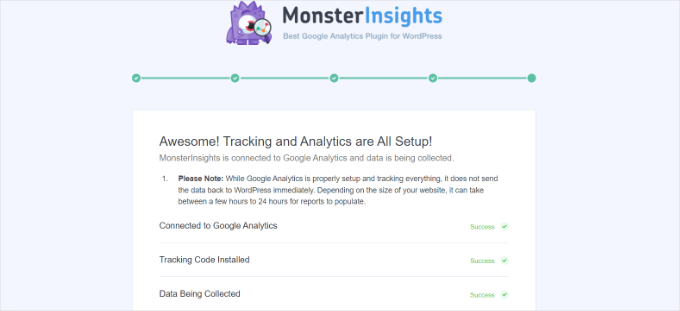
Next, you can scroll down and see a field to enter your license key.
Go ahead and click the ‘Complete Setup without Upgrading’ option for now.
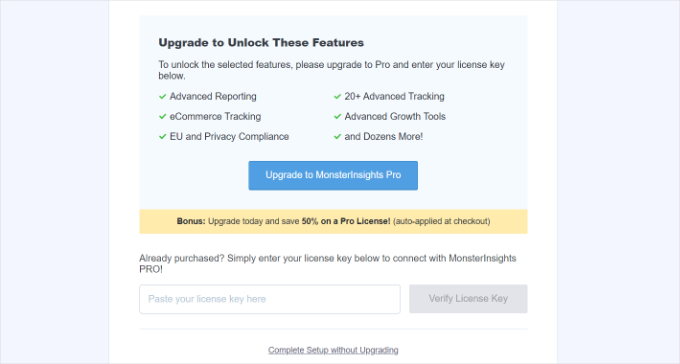
You’ve successfully added Google Analytics to your WordPress website.
Disable Enhanced Measurement in Google Analytics
Now, if you created a Data Stream in GA4 on your own instead of letting MonsterInsights create one, then you’ll need to switch off Enhanced Measurement.
That’s because MonsterInsights adds multiple custom-enhanced tracking features. Leaving the Enhanced Measurement option enabled will skew your data and show incorrect results.
First, you can head to the Google Analytics tab or window in your browser. From here, click on the ‘Admin’ settings option in the bottom left corner.
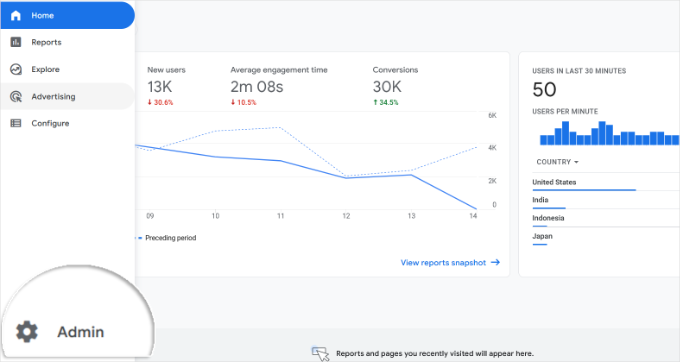
Once you are on the ‘Admin’ page, you’ll see different settings.
Simply click on the ‘Data Streams’ option.
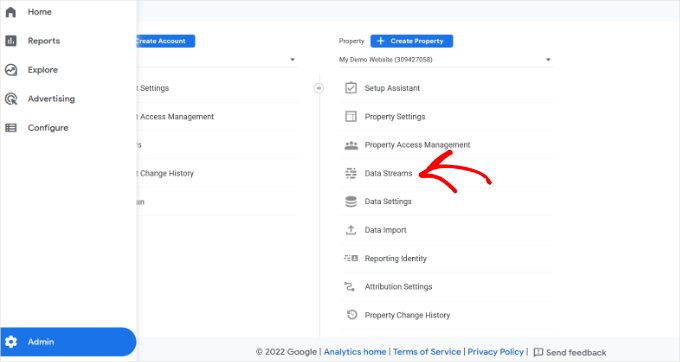
Next, you’ll see your Data Streams.
Simply select the data stream you connected with MonsterInsights.
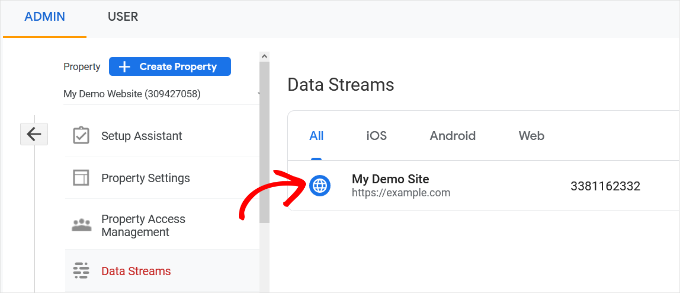
On the next screen, you will need to disable the ‘Enhanced measurement’ option.
To do that, simply click the toggle.
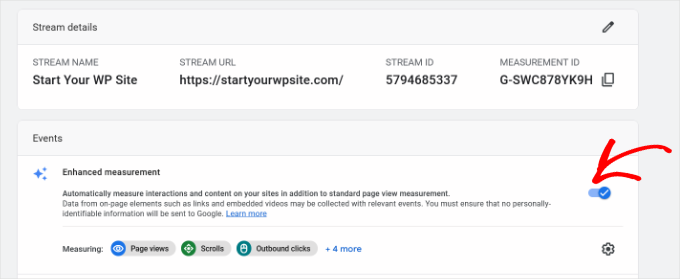
Next, a popup window will open, confirming that you’d like to turn off the enhanced measurement.
Go ahead and click the ‘Turn off’ button.
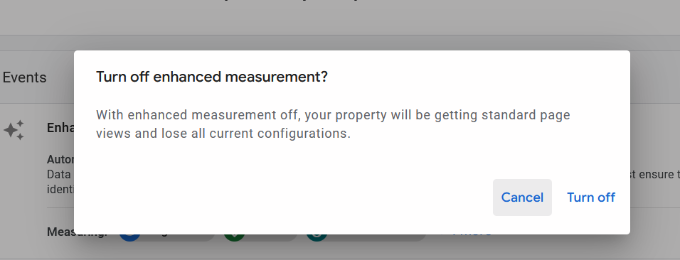
Change Data Retention Settings in Google Analytics
By default, Google Analytics will set the data retention setting to 2 months. However, you can change this so that you can use your data in custom reports beyond 2 months.
First, you need to head to Admin » Data Settings » Data Retention in Google Analytics.
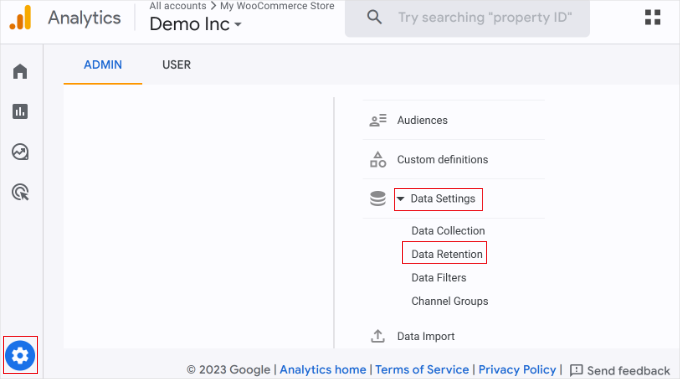
Next, you can click the ‘Event data retention’ dropdown menu.
From here, simply select the ’14 months’ option and click the ‘Save’ button.
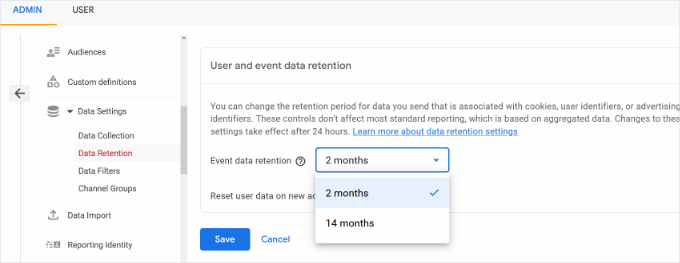
Remember, it will take Google Analytics some time before showing your stats.
💡 Pro Tip: Google Analytics lets you extend data retention to 14 months, but even if you choose the default 2-month option, privacy rules like GDPR still apply.
For that reason, you still need to get user consent before tracking, and it’s a good idea to mention how long you keep data in your privacy policy.
Not sure how to get started? Check out our guide on how to add a cookie popup in WordPress for GDPR/CCPA.
View Google Analytics Reports Inside the WordPress Dashboard
The best thing about MonsterInsights is that you can view your Google Analytics reports inside your WordPress dashboard.
Simply visit the Insights » Reports page to check out a quick overview of your analytics data.
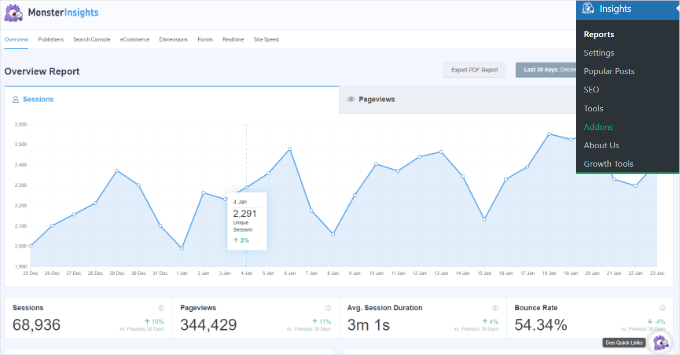
You can also add annotations directly to your MonsterInsights reports to record key changes you make to your website.
For example, you can add a note when you publish a new blog post, add a new landing page, and so on. This makes it easy to track how these events impact your traffic.
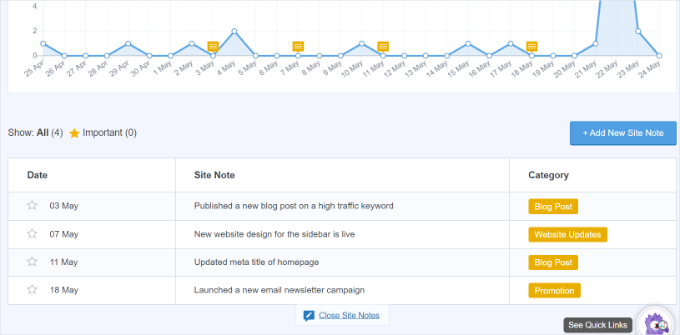
For more details, see this guide on how to get GA4 site annotations in WordPress.
You can even just ask MonsterInsights about the website stats you’re interested in. Thanks to the Conversations AI feature in MonsterInsights Pro.
For instance, if you have an eCommerce website, you can ask how much revenue you made from a product in a specific time period.
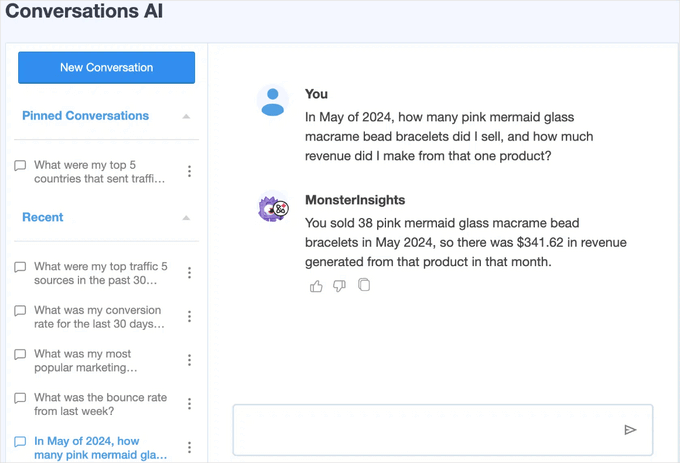
This is much easier than searching through your reports to find the data you need, especially if you’re just starting out with analytics.
In addition, MonsterInsights comes with a Popular Posts addon that allows you to show your top-performing content to boost your traffic and pageviews.
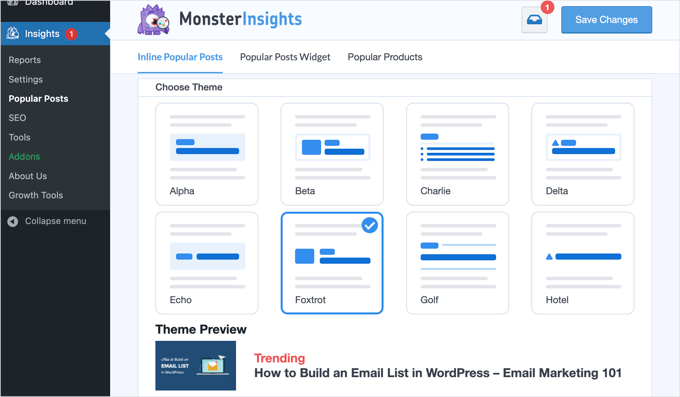
You can use it to automatically add inline popular posts links to boost engagement.
If you are running an online store, it can also automatically add your top-performing products at the end of each blog post to boost sales. (The popular products feature is available in the Pro version of MonsterInsights.)

If you run a WordPress blog, then the Page Insights addon (available in MonsterInsights Pro) will be super helpful.
Once installed, it will automatically add your blog stats in your ‘All Posts’ screen, the front end (while logged in), and the content editor screen.
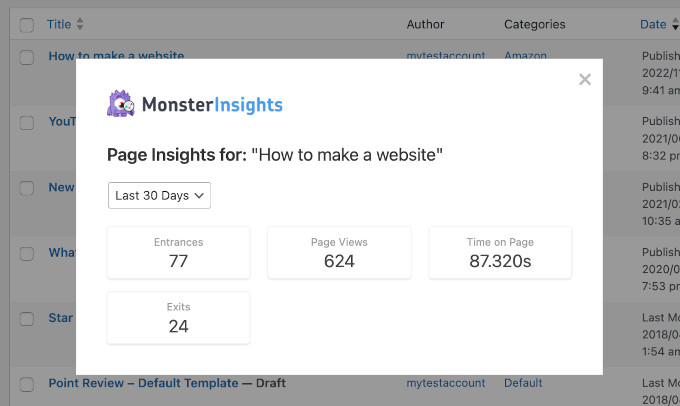
🌟 Insider Note: MonsterInsights was formerly known as Google Analytics for WordPress by Yoast. WPBeginner’s founder, Syed Balkhi, acquired the plugin in 2016 and rebranded it to MonsterInsights. Now, it is part of our family of premium WordPress plugins.
Method 2: Install Google Analytics in WordPress With WPCode
In this method, we’ll show you how to manually install Google Analytics in WordPress. We’ll use WPCode to add the GA4 tracking code to your site’s header.
Before we start, do note that this method is not as good as MonsterInsights because you will not be able to do advanced tracking configuration. Also, you will not be able to view Google Analytics data in your WordPress dashboard.
The WPCode plugin lets you safely add custom code snippets to your WordPress site without editing theme files.
Some of our business partners use WPCode to manage tracking scripts, custom features, and other advanced settings, and it’s been working exceptionally well. To learn more about the plugin, check out our full WPCode review.

First, copy the Google Analytics tracking code (Global site tag) that you created in Step 4 when setting up your Google Analytics account.
Here’s what it might look like in the interface:

Next, you need to install and activate the WPCode plugin. For more details, see our step-by-step guide on how to install a WordPress plugin.
📝 Note: You can use the free WPCode plugin to install the Google Analytics tracking code.
But upgrading to WPCode Pro unlocks more powerful features — like complete revision history to help you track changes and code scheduling to automatically enable or disable snippets at specific times.
Upon activation, you need to visit the Code Snippets » Header & Footer page. Here, you must paste the Google Analytics tracking code that you copied earlier into the ‘Header’ section.
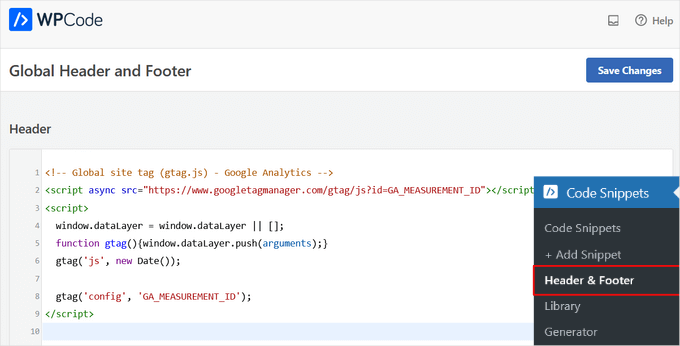
Don’t forget to click the ‘Save Changes’ button to store your settings.
That’s all, you have successfully installed Google Analytics on your site.
Method 3: Install Google Analytics in a WordPress Theme
⚠️ Warning: This method is only for advanced users. It involves editing your theme’s code directly, which can easily break your site if done incorrectly.
Another downside is that your tracking code will be lost whenever you update or switch themes, making this method unreliable in the long run.
If you’re not comfortable editing code, we strongly recommend using Method 1 (MonsterInsights) or Method 2 (WPCode) instead.
In this method, we’ll show you how to add tracking code manually without using a plugin. This gives you full control over where the script goes in your theme files.
That said, it’s best suited for advanced users who are comfortable working with code.
To do this, you will first need to copy the Google Analytics tracking code that you copied in Step 4 earlier. You can view it in the Web Stream Installation section under the ‘Install manually’ tab.

Now, there are two common ways to add this code to your WordPress theme files. You can choose either one of them (not both):
Add Code in header.php File
Simply edit the header.php file in your WordPress theme and paste the Google Analytics tracking code you copied earlier, placing it immediately before the closing </head> tag.
Don’t forget to save your changes and upload the file back to your server.
Add via Functions File
You can also add Google Analytics tracking code to the WordPress functions file. It will then automatically add the tracking code to every page on your WordPress site.
You will need to add this code to your theme’s functions.php file.
<?php
add_action('wp_head', 'wpb_add_googleanalytics');
function wpb_add_googleanalytics() { ?>
// Paste your Google Analytics tracking code from Step 4 here
<?php } ?>
Don’t forget to replace the ‘Paste your Google Analytics tracking code from Step 4 here’ section in the above snippet with your Google Analytics code.
Bonus Tip: How to View Reports in Google Analytics
Google Analytics is capable of showing you a treasure trove of data collected from your stats. You can view this data by visiting your Google Analytics dashboard.
Google Analytics 4 reports are a bit different from previous Universal Analytics reports. In the left column, you’ll see a dedicated Reports option. The reports are grouped together under 2 broad categories: Life Cycle and User.
One of the most noticeable differences you’ll find in GA4 reports is that bounce rate is calculated differently. It’s now the percentage of sessions that were not ‘engaged,’ which gives you a clearer picture of how visitors interact with your site.
Other than that, you’ll find a new reporting interface, new metrics like engagement time, no goals in GA4, and more.
Here’s a breakdown of the different reports in Google Analytics 4:
- Realtime: Shows active users on your site right now.
- Acquisition: Shows how users found your website (e.g., organic search, referrals, email).
- Engagement: Shows what users do on your site, including key events and conversions.
- Monetization: Tracks eCommerce data, such as purchases and revenue.
- Retention: Shows how well you retain visitors by comparing new vs. returning users.
- User Attributes: Breaks down your audience by country, city, gender, and interests.
- Tech: Shows which devices, browsers, and operating systems people use to view your site.
You will see these Google Analytics reports in the left column. Each section is divided into different tabs, and clicking on a tab will expand it to show more options.
Here’s what it might look like in the reporting dashboard.
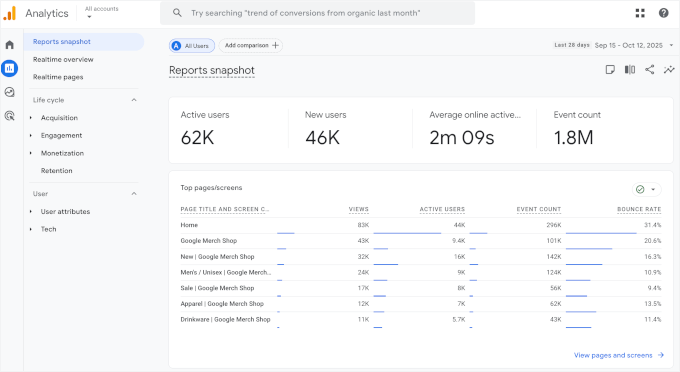
🧑💻 Pro Tip: We also highly recommend connecting Google Analytics with Google Search Console. This allows you to see how your site performs in search results. See our complete Google Search Console guide to learn how to use it to grow your website.
Finally, to improve your WordPress SEO rankings and get more traffic, we recommend using the AIOSEO plugin. It’s a complete toolkit that helps you optimize your site with sitemaps, schema markup, and everything else you need to rank higher.
There’s a free version of AIOSEO that you can use to get started.
FAQs About Installing Google Analytics in WordPress
Here are answers to some of the most common questions we get about setting up Google Analytics.
Is Google Analytics free to use?
Yes, Google Analytics is completely free. They offer a premium version for very large enterprise websites, but the free version is more than powerful enough for the vast majority of small business sites and blogs.
How long does it take for Google Analytics to start working?
After adding the tracking code to your site, Google Analytics may take a few hours to begin collecting and displaying data in your reports. We recommend checking back after 24 hours to see your first full day of statistics.
Do I need Google Analytics if my site has Jetpack stats?
Jetpack stats provide a simple overview of your traffic.
But Google Analytics is a much more powerful and comprehensive tool. It gives you far more detail about your audience, their behavior, and how they found your site, which is essential for making informed decisions to grow your website.
For details, see our comparison article on Google Analytics vs. Jetpack Stats.
Video Tutorial: Install Google Analytics in WordPress
Before you go, don’t miss our video tutorial on how to install Google Analytics in WordPress to see the process in action. ▶️
Keep Learning: Using Analytics to Grow Your WordPress Site
We hope this article helped you learn how to install Google Analytics in WordPress.
Next, you might want to see some more resources that will help you make the most out of Google Analytics reports:
- How to Track User Engagement in WordPress with GA
- How to Set Up WordPress Form Tracking in GA
- How to See Search Analytics in WordPress
- How to Track Outbound Links in WordPress
- How to Keep Personally Identifiable Information Out of GA
- How to Get a Custom Email Alert in Google Analytics
- How to Track WooCommerce Customers in Google Analytics
- Ultimate Guide to GA4 in WordPress for Beginners
If you liked this article, then please subscribe to our YouTube Channel for WordPress video tutorials. You can also find us on Twitter and Facebook.





Amy
In a switch to self hosting that has been so difficult, THIS was so helpful, and so simple to perform myself!
Paul Carr
Great tutorial with easy to follow step by step details.
I used this to set up Google Analytics on my blog using the free Monsterinsights plugin recommended in method one.
It took me about six minutes, and that included reading through the tutorial steps one at a time as I completed each one.
Many thanks!
WPBeginner Support
Hey Paul,
Thanks, we are glad that you found the article helpful. You may also want to subscribe to our YouTube Channel for WordPress video tutorials.
Admin
Josh
Finally what I been looking for! Thank you
Rex
Oddball question…but would it be possible to manually install Google Analytics (via headers theme & functions.php file) AND use a Monster Insights plugin? Assuming the same Google account tracking ID/code is used.
It’s not necessarily something we would do, just wanted to answer a client’s question.
(hope this makes sense)
Thank you,
Rex
WPBeginner Support
Hey Rex,
No it will cause double tracking issue.
Admin
Rex
Ah, now that’s interesting…
Also, thanks for the tutorial. Very helpful!
Karma
I tried the third way and did everything as instructed. After completing everything, my google analytics dashboard does not show any data. Can somebody help me with more details. The website was developed in Wordpress and i do not want to use the first method with plugin.
Katie
I tried this also and it doesn’t show any data either. However, on Activate it shows that my analytics are working and show my monthly users and unique users. Why am I not seeing any of this in Google Analytics?
Dan McCreight
THANK YOU! It’s really nice when someone takes the time to make a complicated process seam easy.
ihsan khattak
Thanks for this very informative post
Ruth
Thanks for this! I was starting to feel a bit overwhelmed, but this article made it super easy.
Laura Jevtich
Thank you so much for this article. I had a feeling it was going to be a plugin. Used to use Dreamweaver which had great ways to do SEO, but not so great with everything else. I’ll make sure to follow for other great insight.
Wendy Brentnll-Wood
Thanks this post was easy to follow and the links were really useful. I’m sure it saved me a lot of time getting analytics set up on a couple of new websites. Many thanks!
Karen
When I try to set up in Wordpress this works great until I get to adding the Authentication code. When I enter it, it either tells me “Bad Cod” or “Connection Error.” My host is Godaddy.
Thank you!
SJ B
Massively grateful for the ‘insights’ (ba dum ching!) you’ve provided here. Sorry about the pun. I’m just happy to finally be able to have a play with analytics. Thank you.
Navin Rao
It was a very detailed step by step explanation..Was helpful ..
You got a awesome theme, it’s very light loved it.
Thanks,
Navin Rao
Barnali
Excellent tutorial. I have been trying to use Google Analytics and this post of yours was very helpful.
Regards
(Barnali)
LaToya C
This was very helpful. Thanks for sharing!
Danielle
I entered in the code and it changed the color scheme of my entire page. I deleted the code and it went back to its original state. Why is this happening?
Rob
Hi,
Thanks, using Monsterinsights was easy. However, the google analytics code appears on all my pages in the upper left side. How do I hide the google analytics code from website?
Tank you.
WPBeginner Support
Hi Rob,
Try switching to a default WordPress theme like (Twenty Seventeen). It this resolves your issue, then most likely your WordPress theme is not using wp_head function which is required by WordPress.
Admin
Ebubedike Felix
love this lesson. thanks
Ed Schmidt
I did the easiest method and have the plug in on my wordpress ran site. To be clear if I did this method and followed all the steps I should start tracking immediately although results won’t show for a while. I did not ever copy and paste the universal tracking code anywhere but that was not in any steps that I saw. So if I did the steps it should work?
Thanks
Joyce
This was a very helpful article! Thank you very much!
Lisa
Very helpful article thank you! Exactly what I needed to know!
Jeff
1) I tried to put the code in my functions.php file and did not really pay attention. It did not work. On closer inspection, it is not really clear what I should be pasting and what is just there to help locate the code. Also, it is backwards (add action vs function) from my other code setting up my child theme. As a newbie to pho I do not know if this matters. Anyway, moved on
2) I am now using my theme >Theme Options>Custom Code>Footer Code and inserted the Google script direct into this. Is this okay without all the doings of all the plug ins?
Thanks
Shawn Vaillancourt
In regard to the step where you “select profile”, the analytics profile that is, mine says “select a profile”. However, there is no profile to choose from. Any idea why?
Shawn
WPBeginner Support
Hey Shawn,
This issue was caused by certain WordPress themes and plugins, it has been resolved in the latest version of MontserInsights. Please update your plugin. Let us know if you come across any issue.
Admin
Morgan Anderson
This was a great tutorial and so easy. Thank you for sharing!!
Scott
Performance impact of installing this?
Simone
Hi,
It is a very helpfull article, but I have a problem. When I reach the point where I’m supposed to select a google analytics profile, there aren’t any options to choose. I have created a google analytics profile by following the steps you show, so I don’t know why it doesn’t show up. Do you have any idea why it doesn’t work?
WPBeginner Support
Hi Simone,
Make sure you are logged in with the same Google/Gmail account that you used to create your Google Analytics profile. Next, you can visit your Google Analytics dashboard to make sure that your website profile is there.
Admin
margot
Hi! I’ve got the same problem! And I am logged in with the same google account + the google analytics dashboard shows my profile so there is no issue there. I’ve tried it two times already and it’s always at that last step that there is no profile to select…
WPBeginner Support
Hi,
There is an update available for MonsterInsights which should address this issue.
Ramesh
Very informative!
This is what a new bee of wordpress expects to know.
Good article! Will share for the needy
Bogdan
Thank you very much for this article! I always find you articles very helpful. Still, I didn’t find the report tab.
Geoff
Hi. I am using WP v4.7.2 and my theme is Traffica.
I have loaded the code in the footer section as suggested and replaced the text with my GA code. When I update and reload my web page, all I see is the GA code. Please can you advise where I am going wrong?
Chelsea
If you install this in the “insert header footer” plug-in and save, will that apply tracking to EVERY page on the site? So it will track data from every page? Thank you!
WPBeginner Support
Yes it will track data from every page.
Admin
aisha
Will tracking be for every page just when using the MonsterInsights plugin? And how long does it take to start tracking? I have been playing around on my site but have not noticed any reports so far. thank you!
WPBeginner Support
Hi Aisha,
Yes, it will track all pages on your WordPress site. Normally, Google Analytics takes sometime before you can start seeing reports.
David
I have been looking for this tutorial.very nice explained. Thank you
Nailil
Thanks for this tutorial!
Monet
Hi. Thank you for the tutorial. I think I set up my analytics correctly. How long does it take to track data? And how can I tell if I set it up correctly?
Chima ogbonnaya
Thank very much after reading your post about wordpress blogging I started and it is moving and working well Thanks..
WPBeginner Support
Hi Chima,
Glad to hear that Don’t forget to follow us on Facebook for more WordPress tips and tutorials.
Don’t forget to follow us on Facebook for more WordPress tips and tutorials.
Admin
Thabiso
Thank you for this wonderful tutorial.
Kristel Miley
Thank you so much for this tutorial! It was simple and easy to follow, and I now have google analytics set up. So glad I found this website!
WPBeginner Support
Hi Kristel,
We are glad you found it helpful. You may also want to subscribe to our YouTube Channel for WordPress video tutorials.
Admin
Arash
Hi, thanks for the helpful info!
I’ve added the code snippet in header section, now that i need to modify the code for each page for GA remarketing purpose, how can i do that?
nisrina
thanks you very much, this really help me to set my analytics
James
Thanks! Did the trick!
Jasmine A
I noticed on the wordpress plans page it said you need a business plan to have google analytics, is this true or is it just a way to get you to purchase this plan?
WPBeginner Support
Hi Jasmine,
You are looking at WordPress.com plans. Please see our guide on the difference between self hosted WordPress.org vs free WordPress.com blog.
Admin
Alex
Thank you so much this was easy and solved a huge problem for me.
Nathan K Smith
For those that don’t know make sure you pick whether your site is http or https.
Kshitij
I’m done this much. How and where can I see the results and tracked details?
Peru
Hello there,
If I add the tracking code to header.php, will it disappear when the theme updates?
In other words, is header.php a ‘theme file’?
Thanks for your help
WPBeginner Support
Yes, header.php is a theme file.
Admin
Mark
It’s best to create a child theme and adding the code to the child theme’s file, so that it is not affected when the theme updates.
Pawan Sahani
This article helped me solve my problem. Thank You
prettypenguin
in video, you said add the codes to ‘footer.php’ in plugin, but in article you said add to ‘header’. which one should i add?
WPBeginner Support
You choose either of them. However, header is recommended by Google so that it loads first.
Admin
Luna
Thank you! You made this soo easy
Sharon LoMonaco
I’ve just had a Google Analytics DISASTER! My WordPress dashboard indicated that the Google Analytics plugin needed an update.
This is the result!
Parse error: syntax error, unexpected T_PAAMAYIM_NEKUDOTAYIM in /home/content/p/e/n/penchant52/html/redscarfsociety/wp-content/plugins/googleanalytics/class/Ga_Admin.php on line 480
Website crashed or absolutely unavailable. NO DASHBOARD! NOT ABLE TO LOG IN!
HOW IS THIS GOING TO GET FIXED?
WPBeginner Support
Hi Sharon,
First you need to deactivate all plugins on your website. See our guide on how to deactivate all WordPress plugins when not able to access admin area.
Admin
Anuj Sharma
Thanks for the explanation!!!
WPBeginner Support
You are welcome
Admin
eli
Hello so it seems that i am doing something wrong my sites aren’t being tracked correctly? I originally started with a sub domain and an xyz domain . And then someone suggested to purchase .com domains if i wanted to get better rankings and more traffic. So i went ahead and changed them Here’s where the problem begins. Now when I track them on real time there is no sign of my tracking results on either of them and on one no results what so ever. So if you have any suggestions please give me some advice
Atul Thakur
so you said you were using your google analytics on some other domain and then you purchased a .com domain. Did you added that domain to your google analytics account also when you register your .com domain on google analytics you will get a code please use that code don’t use your old code from other domain